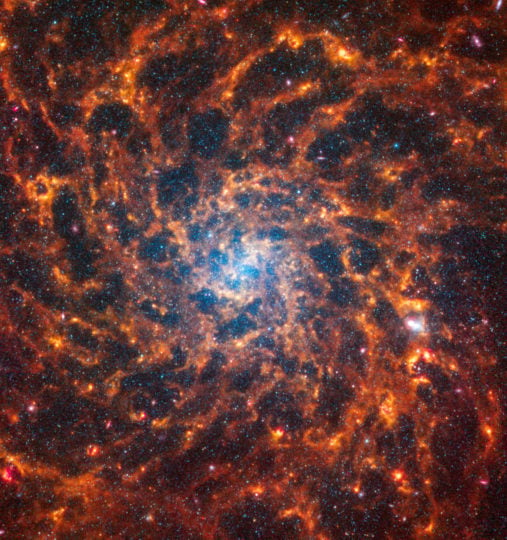A new treasure trove of the NASA/ESA/CSA James Webb Space Telescope images showcases near- and mid-infrared portraits of 19 face-on spiral galaxies. This new set of exquisite images shows stars, gas, and dust on the smallest scales ever observed beyond our own galaxy.
![This collection of 19 face-on spiral galaxies from the NASA/ESA/CSA James Webb Space Telescope in near- and mid-infrared light is at once overwhelming and awe-inspiring. Webb’s NIRCam (Near-Infrared Camera) captured millions of stars in these images. Older stars appear blue here, and are clustered at the galaxies’ cores. The telescope’s MIRI (Mid-Infrared Instrument) observations highlight glowing dust, showing where it exists around and between stars – appearing in shades of red and orange. Stars that haven’t yet fully formed and are encased in gas and dust appear bright red. Webb’s high-resolution images are the first to show large, spherical shells in the gas and dust in such exquisite detail. These holes may have been created by stars that exploded and carved out giant regions in the interstellar material. Another eye-catching detail? Several galaxy cores are awash in pink-and-red diffraction spikes. These are clear signs that these galaxies may have central active supermassive black holes or central star clusters. These spiral galaxies are Webb’s first big batch of contributions to the Physics at High Angular resolution in Nearby GalaxieS (PHANGS) program, that includes existing images and data from the NASA/ESA Hubble Space Telescope, the Very Large Telescope’s Multi-Unit Spectroscopic Explorer (MUSE), and the Atacama Large Millimetre/submillimetre Array (ALMA). With Webb’s images, researchers can now examine these galaxies in ultraviolet, visible, infrared, and radio light. [Image description: Nineteen Webb images of face-on spiral galaxies are combined in a mosaic, some within squares, and others horizontal or vertical rectangles. Galaxies’ spiral arms appear in shades of orange, and many of their centres have light blue hazes.]](https://ideasanddiscoveries.online/wp-content/uploads/2024/02/PHANGS_image_mosaic_pillars-540x540.jpg)
This collection of 19 face-on spiral galaxies from the NASA/ESA/CSA James Webb Space Telescope in near- and mid-infrared light is at once overwhelming and awe-inspiring.
Teams of researchers are studying these images to uncover the origins of these intricate structures. The research community’s collective analysis will ultimately inform theorists’ simulations and advance our understanding of star formation and the evolution of spiral galaxies.
If you follow each of the galaxy’s clearly defined arms, which are brimming with stars, to their centres, there may be old star clusters and – sometimes – active supermassive black holes. Only the James Webb Space Telescope can deliver highly detailed scenes of nearby galaxies in a combination of near- and mid-infrared light – and a set of these images were publicly released today.
These Webb images are part of a large, long-standing project, the Physics at High Angular resolution in Nearby GalaxieS (PHANGS) programme, which is supported by more than 150 astronomers worldwide.
Before Webb took these images, PHANGS was already brimming with data from the NASA/ESA Hubble Space Telescope, the Very Large Telescope’s Multi-Unit Spectroscopic Explorer, and the Atacama Large Millimeter/submillimeter Array (ALMA), including observations in ultraviolet, visible, and radio light. Webb’s near- and mid-infrared contributions have provided several new puzzle pieces.

Galaxy IC 5332 was observed as part of the Physics at High Angular resolution in Nearby GalaxieS (PHANGS) programme, a large project that includes observations from several space- and ground-based telescopes of many galaxies to help researchers study all phases of the star formation cycle, from the formation of stars within dusty gas clouds to the energy released in the process that creates the intricate structures revealed by Webb’s new images. IC 5332 is 30 million light-years away in the constellation Sculptor. Image credit:
NASA, ESA, CSA, STScI, J. Lee (STScI), T. Williams (Oxford), R. Chandar (UToledo), PHANGS Team
Webb’s NIRCam (Near-Infrared Camera) captured millions of stars in these images, which sparkle in blue tones. Some stars are spread throughout the spiral arms, but others are clumped tightly together in star clusters.
The telescope’s MIRI (Mid-Infrared Instrument) data highlights glowing dust, showing us where it exists behind, around, and between stars. It also spotlights stars that haven’t yet fully formed – they are still encased in the gas and dust that feed their growth, like bright red seeds at the tips of dusty peaks.
To the amazement of astronomers, Webb’s images also show large, spherical shells in the gas and dust that exploded stars may have created.
The spiral arms’ extended regions of gas also reveal details in red and orange. Astronomers study the spacing of these features to learn how a galaxy distributes its gas and dust. These structures will provide key insights about how galaxies build, maintain, and shut off star formation.
Evidence shows that galaxies grow from inside out – star formation begins at galaxies’ cores and spreads along their arms, spiralling away from the centre. The farther a star is from the galaxy’s core, the more likely it is to be younger. In contrast, the areas near the cores that look lit by a blue spotlight are populations of older stars. The galaxy cores that are awash in pink-and-red diffraction spikes may indicate an active supermassive black hole or saturation from bright star clusters toward the centre.
There are many avenues of research that scientists can begin to pursue with the combined PHANGS data, but the unprecedented number of stars Webb resolved are a great place to begin. In addition to immediately releasing these images, the PHANGS team has also released the largest catalogue to date of roughly 100 000 star clusters.
Source: European Space Agency

